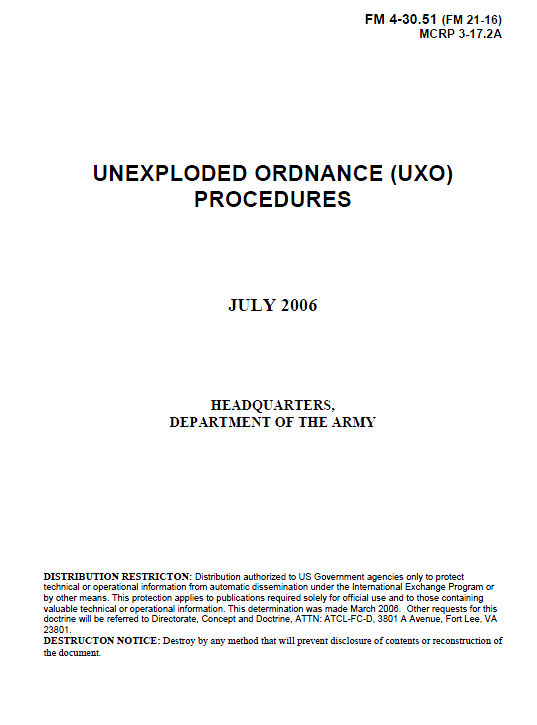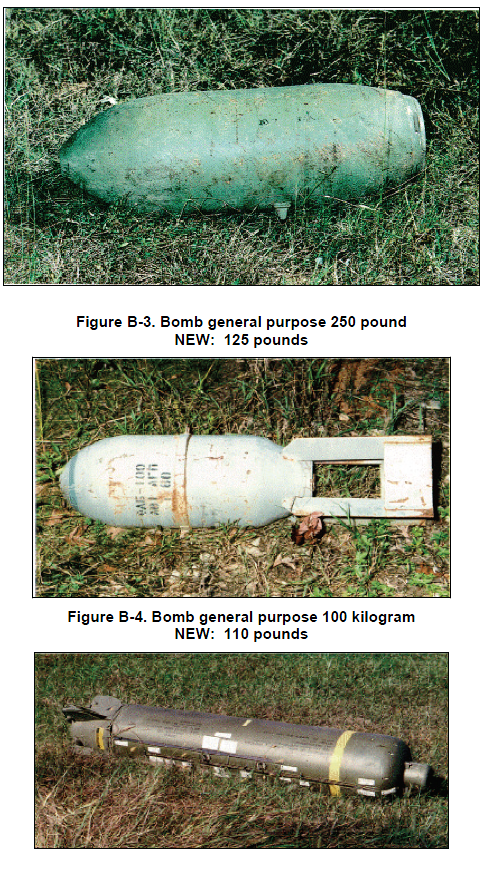FM 4-30.51 (FM 21-16)
- 96 pages
- Distribution Restricted
- July 2006
- 8.1 MB
Field Manual (FM) 4-30.51/Marine Corps (MCRP) 3-17.2A prescribes the doctrine for dealing with the unexploded ordnance (UXO) hazards on the battlefield. Use the information in this manual to teach military personnel, Department of Defense (DOD) civilians, and contractors about the UXO hazards they could meet and the procedures they can use to protect themselves. This manual also gives guidance on how to get help to take care of the hazards that affect mission capabilities.
When personnel find UXO, they must follow these steps:
- Note characteristics of the UXO hazard for purposes of identification.
- Take immediate action (mark and evacuate).
- Report the UXO hazard using the Explosive Hazards (EH) Spot Report (See chapter 4).
- Use protective measures against the UXO hazard, if required.
Based on these steps, FM 4-30.51/MCRP 3-17.2A serves as a general guideline for including UXO hazard procedures in unit standing operating procedures (SOPs). This manual provides information for transmitting and monitoring UXO reports throughout any battlefield functional area (BFA).
SCOPE
UXO on the battlefield affects the mobility and mission aspects of all units. Battlefields are littered with UXO hazards from two sources: ordnance that has either failed to function or ordnance designed to be used for area denial, such as conventional land mines and the family of scatterable mines (FASCAM). With the sophistication of modern weapons systems, battlefield commanders can target anything within their theater of operations. After these attacks are completed, UXO hazards will be left on the battlefield.
UXO hazards may not always pose an immediate threat to unit mission or mobility, but they are hazards that have in the past caused needless loss of life and materiel. Battlefield commanders need to know where UXO hazards are, as these hazards can affect the mobility of follow-on elements. This manual teaches personnel about the UXO hazard and how this hazard affects mission capabilities and what procedures are used to report and protect personnel and equipment. All units should be able to react to the UXO hazard effectively and to report and protect against it.
During mission planning, leaders must coordinate with supporting artillery and air liaison personnel to find out what areas are expected to contain large numbers of UXO. These areas should be avoided if possible. This type of planning makes a unit more mission capable.
There are two types of UXO threats on the battlefield: passive (UXO that is found during unit movement) and active (UXO that results from an attack). All units must be able to react to both of these types of threats in order to survive on the modern battlefield. Chapter 6 of this manual covers procedures for reacting to these threats. Additional information can be found in FM3-34.119 IED Defeat and FM 3-34.210 Explosive Hazards
…



